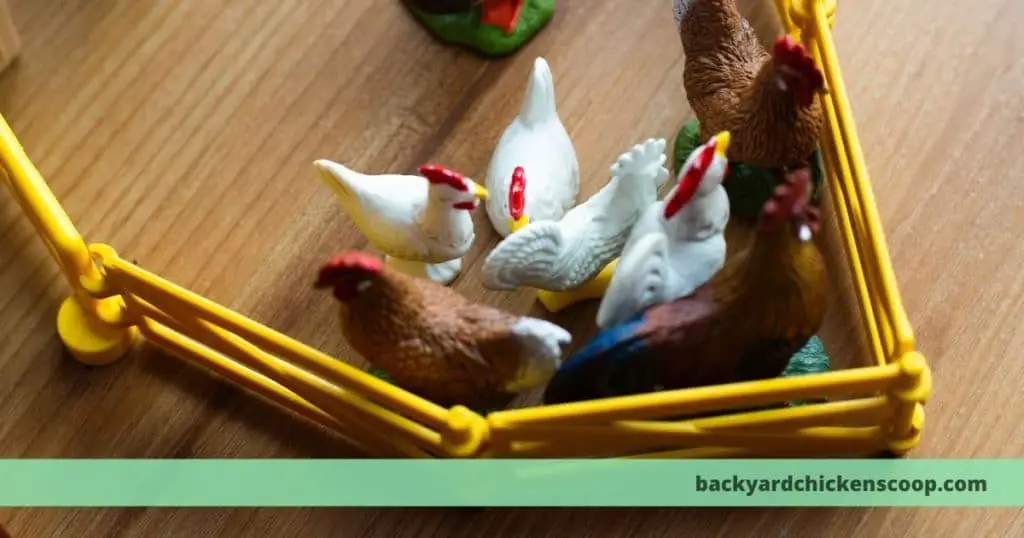I guess you’re planning to raise chickens in your backyard. First of all, it’s a great decision. Chickens are one of the best pets to have. You’ll definitely not regret your decision to have a beautiful flock in the backyard. Here, we are sharing a complete beginner’s guide to raising chickens!
Is it ok to have chickens in your backyard?
Is that even a question? Chickens are just like any other pets. It’s completely OK to have them happily in your backyard. You’ll surely enjoy their company. What’s even better? You’ll get fresh supplies of eggs and chickens at your home. These eggs taste much better than the store-bought ones.
There are several other advantages of raising chickens at your home. However, there are several things that you need to keep in mind while having a flock. It is a great responsibility, you have to always keep an eye on them and protect them from predators. Below are the things you need to keep in mind while raising chickens in your backyard.
Things to consider before getting chickens
First and foremost, check your town guidelines to make sure whether or not having chickens are allowed in your locality or not. Also, check if there is any limit on the number of birds you can keep at your place.
Make sure you have enough space for your chickens. You will need a spacious chicken or hen house. A full-size chicken coop is a great option if you can afford it. You can either buy new or make it on your own. Make sure there are enough feeders, waterers, nest boxes and enough roosting area.
Also, your hen house or coop should be well protected in order to keep the birds safe from predators.
Just like humans, chickens need food and water every day. You have to invest in a gold quality chicken feed which ranges from $20 per bag. Also, birds need an adequate freshwater supply every day.
You will have to collect eggs every day. Hens usually lay from spring to summer and then to the fall. If you’re lucky enough, you might have to collect twice a day.
How many chickens should I keep?
Chickens are extremely social birds. If you only keep one or two of them, chances are they will get upset and bored, which will affect their productivity. So, plan to have at least 3 to 6 birds.
This number will ensure you have enough supplies of eggs daily as a mature hen lays about 2 eggs in 3 days.
Another reason to keep minimum 3-6 chickens is that they are productive for the first two years, after that their laying capability will slow down. So, you have to replace them with the younger birds. You can either hatch the new chicks on your own or you can buy them from a trusted hatchery.
We recommended the later method as you’ll need to have a rooster for hatching your own chicks. The problem with roosters is, they are aggressive in nature and can cause difficulties for a beginner chicken grower. So, if you have no chicken raising experience, consider buying young chicks from the hatcheries.

How much space do chickens need?
The space requirements of the chickens depend mainly on the breeds you’re having. However, on an average, a medium-sized chicken needs about 3 sq ft interior space and about 8 sq ft of running area outside a coop. As a general rule of thumb, more space means a healthier and happier flock.
On the other hand, if they don’t get adequate space and if the coop is overcrowded, feather picking and several diseases will be promoted.
Further, the birds will need space to run freely and spread their wings. So, you can lend them your entire backyard where they can have dust baths, do some hunting, get some sunshine etc. No matter what option you choose, make sure the yard is properly fenced so that the predators can not access the flock and harm them.
How much does keeping chickens cost?
Chicken cost is one of the most important factors to consider while raising chickens. First, a basic chicken coop will cost you around $500. If you don’t want to purchase a new one, you can do this work by yourself or by hiring skilled labour. For that, you have to invest in wood, fencing, hardware and other supplies plus the cost of labour.
Overall, it will cost you around $800 to $1000.
Further, the cost of chickens, their feed and other supplies will require a good amount of investment depending upon the size of your flock.
What are the best chickens for beginners?
Now, the most important thing is, what breeds of chickens should you have?
Because you have no experience with chickens, you should look for breeds that are easy to keep, docile and are very productive.
Having said that, we recommend beginning your chicken journey with the dual purpose chickens as they are less noisy and are excellent layers.
As a beginner, don’t start by having meat birds at first because they require a lot of time, care and attention to produce good meat. So, leave the exotic breeds until the time you gain some experience.
To help you more, we are sharing some of the best egg-laying breeds to get started. All the below-mentioned chicken breeds require less care and produce a lot of high-quality eggs. These are definitely the best chickens to have in your backyard.
1. Rhode Island Red
Rhode Island Reds are the most popular backyard chicken breeds. They are most suitable for beginners as they don’t require much time and care to grow. These birds are very friendly and easy to keep.
Rhode Island Reds are very tough birds, they don’t require much space and lay throughout the year. They lay around 250 brown eggs annually.
2. Buff Orpington
Buff Orpingtons are another easy to keep chicken for beginners. They are well known for their friendly nature and decent laying ability. These birds look very beautiful, you will definitely enjoy them playing and running in your backyard. They make excellent pets and lay about 180 medium-sized eggs per year.
3. Plymouth Rock
The Plymouth Rocks are also popularly known as barred rocks. They are originally from the US and are one of the best dual-purpose chickens.
They produce around 200 eggs per year and the best part is they lay in winters as well.
These birds are very active and friendly. You can train them and have fun with them whenever you want.
4. Leghorn
Leghorns are originally from Italy and came to the US later during the 1800s. They are very friendly chickens and lay throughout the year. They are great egg layers and lay around 250 medium-sized white eggs in a year. They are great to have if you’ve kids at your home.
5. Dominique
If you’re looking for very soft and friendly chickens in your backyard, then look no further than Dominiques. They are extremely docile and don’t require much care. Further, they lay around 180 brown eggs per year.
How long can backyard chickens be left alone?
There will be a time when you need to leave your chickens alone due to personal reasons. But you have to keep in mind that, don’t leave the flock alone for more than 3 days. If you’re planning to go out for more than that, better arrange a chicken sitter. It can be your trusted neighbour, a friend or someone from your family.
If you have someone to look after your flock, you can definitely go out for more than 3-4 days. This is no different than leaving your cat and dog behind. Chickens are simple, they just need their food and water on time and that’s it.
If you’re sceptical about asking your neighbours to look after your birds, then you don’t always have to allow them to peep into your house. You can just ask them to keep an eye on the chickens from the fence and ensure that the birds are alright.
You may also ask them to collect and use the eggs and they’ll definitely love doing that, who doesn’t like to have fresh, organic eggs!
What does backyard chickens eat?
Chickens are big-time eaters. They love eating each and everything that comes to them. Ideally, you should provide them with a combined diet consisting of commercial feed and natural vegetables and fruits. Chickens also love eating table scrapes, so feed them instead of dumping them.
However, there are certain things you should never feed the chickens such as mouldy food items and other toxic plants and food items.
Backyard chickens 101 recommend that your chickens’ diet should comprise 70 % of the commercial feed and 30 % of the natural stuff. This will make sure that your flock is getting all the required nutrients.

Do you put food and water in the chicken coop at night?
The short answer is, No.
You shouldn’t keep the water and food inside the coop at night. The very obvious reason is, chickens do not eat and drink from the time they go to sleep till they get up in the morning.
Below are the common reasons for not keeping food and water in the coops overnight :
- If you leave water overnight in the coop, it will cause moulds and fungi and will also rot the wood in no time.
- The feed can get mouldy. What’s even worse? Certain toxins produced by the moulds are highly toxic to the health of chickens.
- Coop will become messy as birds will attack the feeders and waterers as soon as they get up. You’ll have to clean more often.
- Other creatures like rats and mice will get attracted to the feed and will end up hunting your flock.
So, keep the food and water in the coop during the day and carefully remove them during the nighttime. It will not only save you from cleaning the mess inside the coop but will also keep unwanted visitors away from your lovely birds.
Why do chickens need grit?
Generally, the natural grit is a collection of pebbles, coarse sand and small objects chickens eat from the ground while pecking. This grit helps the birds to break down and digest the food particles with ease. This is the reason why you need to provide them with good quality grit.
The grit requirements of chickens is a subject of debate. Usually, the birds that are mostly dependent on the commercial feed like pellets and chick crumbles, don’t require much grit because these feed particles get simpler due to the saliva itself. Also, if you’re feeding whole grains to your chickens, they can easily digest it without the help of the grit because their gizzard muscles become much stronger.
However, if you’ve allowed your flock to forage, they will pick the natural grit from the ground which will help them to digest the hard and fibrous food they eat. To make sure your birds have adequate grit, go with the free-range option.
If you want to learn more, you can read my complete guide to chicken grit here…

What supplements should I feed my chickens?
At the time you will go for buying the commercial feed for your flock, you will also be offered certain chicken supplements. So, the biggest doubt in a beginner’s mind is, whether or not the external supplements are essential? If the daily food is enough or not for your chickens?
The answers to these questions are very subjective. Although most of the good quality chicken feed fulfils all the dietary requirements of the chickens, there are some supplements that can help your chickens to grow more healthy and happy.
The best and the most common supplements for chickens are calcium and grit. These supplements ensure that the nutritional requirements of the chickens are well balanced.
Chicken supplements – Calcium and grit
Generally, during and after the moulting season, pullets might not help themselves to take supplements. So, when you offer calcium as a free choice, they happily take enough amounts of it. Moreover, you can offer them calcium during the winters and fall as well
Calcium
Some hens don’t take a long break from laying after the moulting season and also, the younger girls require extra calcium in their first year of laying. So, offering them enough calcium as a free-range option helps them to take enough as per their needs. It also prevents overeating in birds.
A good source of calcium is crushed oyster shells that you can easily get from your local feed store. You can even use the eggshells from your own eggs. Just collect the eggshells, rinse them and dry them in sunlight. Once they become completely dry, crush them into smaller pieces and you’re good to go. Moreover, feeding eggshells to your flock will not encourage them to eat their own eggs.
Calcium helps the chickens in a number of ways. First, it keeps the hens warm during moulting season. Further, it helps in the formation of better and stronger eggshells. Most importantly, it keeps your flock away from calcium deficiency.
Grit
Just like calcium, grit is also a great chicken supplement. As we already discussed, if your birds are free-ranging, they will get enough grit naturally that will help them grind the hard food particles. But if they’re not allowed to free-range or there is a lack of natural grit, you should offer them good quality grit. In the absence of it, your crop might be impacted.
Talking specifically about grit, it is widely available in two categories: the chick grit which is very finely sized and the regular grit which is a bit bigger in size. You can get anyone depending upon the size of your birds.
Other natural supplements and treats for the chickens
Apart from calcium and grit, there are certain natural food items that make great chicken supplements. What’s better is, they act as amazing treats for the birds. Some of them include sunflower seeds, pumpkin seeds, raisins, oats, rice, flax seeds etc.
But here is one thing you should always keep in mind, don’t overfeed them these treats. Offer them only sparingly. Apart from these, you can always include green leafy vegetables and fruits into their daily diet to keep them healthy and happy.
Chicken coop requirements
As we already mentioned, chickens need a spacious place where they can play and run happily. Providing them with a better shelter should always be your first priority. So, begin with deciding how many birds you’re planning to keep in your backyard. This will help you in determining the total space requirement for the flock.
The better idea is to build or purchase a large-sized coop in case you decide to expand your flock in future. This will provide extra space for your chickens and will keep you free from shelter stress while expanding the flock later on.
Below are the things to consider while building a coop :
- If you’re willing to provide outdoor run space, then you can allow 2 to 3 sq ft per chicken inside the coop. Also, if you can afford it, then don’t think much about building a larger coop.
- If you don’t allow your chickens to outdoor forage, then keep at least 10 sq ft per bird.
- If you’re considering a chicken tractor, 5 sq ft per bird should be enough.
These are the basic guidelines to consider whilst purchasing or building a chicken coop. However, the coop requirements depend greatly on the breeds you’re having. Obviously, a larger chicken or a meat bird with rapid growth will require more space than the young chickens and hens.
Further, if the coop is under-sized, you might have to suffer certain difficulties like aggressive behaviour, pecking among your birds. So, it’s always better to have an oversized coop.
What should be the important features of a chicken coop?
Chicken coops are available in a variety of ranges and have a number of features. You can get a simple basic chicken coop surrounded by fencing, to a highly modernised and well-equipped coop at thousands of dollars. You can buy anyone depending upon your budget. However, whichever coop you select, make sure it has some basic features.
These are as follows :
1. Nestboxes
If you’ve laying hens, then you’ll definitely need some good nesting space for them. The good idea is to have one nest box per three to four hens. Don’t get overwhelmed and plan for extra nest boxes because in such cases, your hen will become broody and will sit in one next box for hatching the eggs.
Always keep the nest boxes minimum 2 feet away from the ground and they should be at least one sq ft long. You can use plastic tubs, milk crates and other similar boxes to make nesting space for your pullets. Just line them with straw and you’re good to go.
2. Roosting space
As a rule of thumb, provide at least 10 inches of roosting space to each chicken. The roost should be 2 feet above the ground. You can use anything like leaders, twigs to make the roosts.
3. Ventilation
Make sure the coop is well ventilated. This helps the elimination of the toxic gases from the coop and keeps the interior environment of the coop clean and fresh.
4. Dust baths
Chickens can’t do without dust baths. So, make sure your coop has an area where you can pile up some dirt and dry soil for their dust baths. You can simply keep a bucket of dry soil or sand for your birds.
5. Predator protection
This should be your biggest concern. Predators are always ready to attack the poor birds. So, it’s your responsibility to keep your birds safe and healthy.
How many chickens can you put in a 4×8 coop?
You can safely put around 10 to 12 birds inside a 4×8 chicken coop. There are some sources that state that you can keep 15-20 birds inside the 4×8 coop, which is wrong. You should provide 3 Sq ft coop space per bird. So, don’t overcrowd your coop unnecessary otherwise it will impact the health and well being of your birds.


